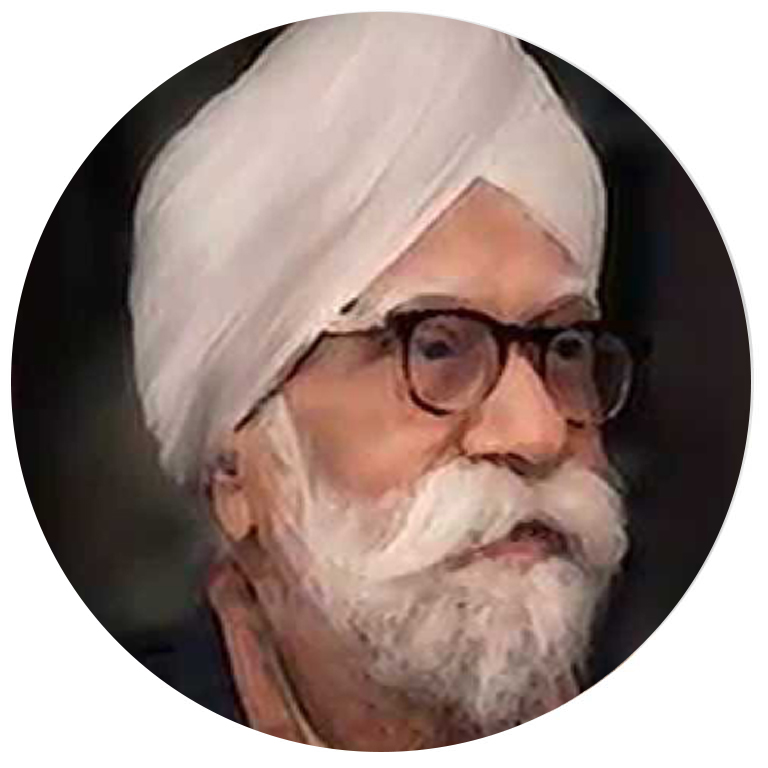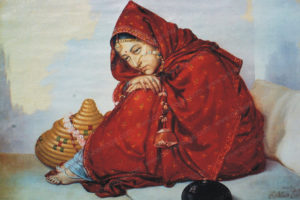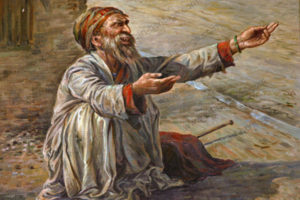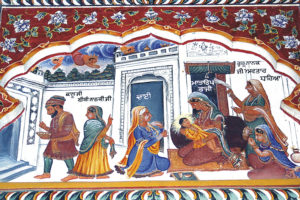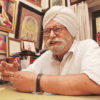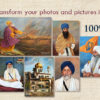Bhai Gian Singh Naqash (1883-1953)
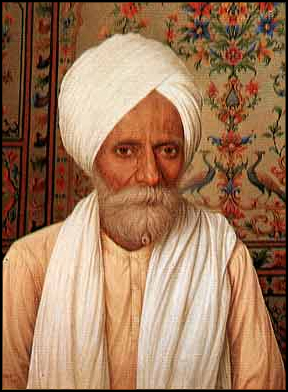
Painting by G.S.Sohan Singh of his father Bhai Gian Singh Naqqash (1883-1953). Bhai Gian Singh kept alive the fast vanishing art of ‘Naqqashi’ (fresco) (back ground of painting). He dedicated his entire life to decorating the walls of Sri Harmandir Sahib. Sohan Singh used his father’s initials in front of his own name, thus G.S.Sohan Singh.
One of the branches of the Sikh School of Art, known as Mohra Qashi (Fresco Painting), was started by Bhai Kehar Singh Naqqash of Amritsar in this region. His works are marked with suave delicacy of line, and his figures carry the soft impress of innocence and chastity on their faces. This quality was honestly inherited by his nephews Bhai Kishan Singh and Bhai Bishan Singh who are reckoned among the great Artists of Fresco Painting of their time. Bhai Nihal Singh and Bhai Jawahar Singh, both sons of Bhai Bishan Singh, followed the footsteps of their illustrious father.
Bhai Gian Singh Naqqash (born 1883 A.D.), who ultimately proved to be a top-ranking Master Artist in fresco Painting, was the devoted disciple of the last named two Naqqashes. He was born in the house of Shri Taba Singh, in Bazar Kaserian, Kucha Tarkhana (opp. Mandir Shri Doonga Hanuman), Amritsar(Punjab). For 32 long years, Bhai Ji offered fresh and still more fresh flowers of his artistic creations in the service of the Golden Temple, Amritsar. Some of the main works executed by him in the shrine are : One large Dehin in Tukri Work on the Southern outer wall of Harimandir Sahib in the Golden Temple Amritsar. Subsequently, he executed further 3 Dehins with delicate Naqqashi work on the sides of the main Dehin.
Further, very delicate Naqqashi work was brought out by him in a large size Bush on the South wall of the Bukharcha. Thereafter he formulated a fine Jal (Network in Mohra Qashi style) on the face of the floor which was also prepared by him. Subsequently he handled repair work of the large Domes above and carried out Mohra Qashi work on the inner walls of Harimandir Sahib. In 1970 Bikrami he executed four Chhakoras (inverted pots attached to the 4 corners of the ceiling of Hari Mandir Sahib) in fine Tukri work; repaired the four Chhipras made out in diamond shaped glass Patthas on all the four sides. On the Eastern outer Wall door of Parkash Asthan (Harimandir Sahib), Bhai Ji executed, on top of the entrance, projected golden letters of verse from Shri Japji Sahib in Gach work in 1974 Bikrami.
The brief account given above shows the dedicated efforts made by Bhai Ji for the embellishment of Harmandir Sahib, as a befitting Abode ! Besides, it is a fortunate coincidence that a large number of his other original works have been preserved in his family as a precious legacy, and collectively serve as a window to our cultural heritage. Bhai Ji executed several paintings on imaginative subjects, poetic themes and verses from Shri Guru Granth Sahib. Some of his paintings are in possession of men in high state in the religious, social and cultural fields.
In recognition of his meritorious services, Bhai Ji was honored with the rare grant of a Siropa by the Siromani Gurudwara Parbandhak Committee in the year 1949. The Indian Academy of Fine Arts celebrated his 35th Death Anniversary on 30th Oct 1988. At this occasion, certain outstanding dignitaries paid rich tributes to the Late Bhai Ji in recognition of his outstanding service to the Art world, and above all, his rare qualities as a top-ranking Artist as well as an ideal human being.
Bhai Ji had three sons. The eldest Son Shri Sunder Singh was martyred in Jallianwala Bagh massacre at Amritsar on Baisakhi Day, the 13th of April, 1919, at a young age of 17 years. He was deeply interested in Art and had gained extra-ordinary proficiency in drawing; but met a tragic fate !
The second son Shri Jagat Singh has now been practicing Ayurvedic System of Medicine for 58 years and is very popular in the profession. The third son, Shri G.S. Sohan Singh is an Artist of International repute. He has dedicated his entire life to the service of aesthetic. A number of his paintings are the proud possessions of dignitaries in high State in India and abroad, Army centers, schools, colleges, museums etc. Bhai Gian Singh was an outstanding personage who minutely understood, practiced and explained the innermost fundamental techniques that make Art and Architecture great. A number of books on these subjects were prepared by him for the benefit of general public. Some of his outstanding printed books on Art are :
- a) Naqqashi Darpan
- b) Naqqashi Art Shiksha
- c) Taj-I-Zargari dealing with the designing and execution of beautiful gold and silver ornaments of all types.
- d) Kasheeda- Art Book dealing with designing and execution of beautiful Naqshas on Shawls and other fabrics.
Similarly, Bhai Ji has rendered yeoman service in the field of Architecture. He has given a very vivid account in respect of the technique as well as materials used, in respect of various phases of masonry, carpentry, smithy, marble work as practiced in the construction of Architectural Structures to ensure durability with beauty of form. An abridged know-how is explained and illustrated by him by step-by-step method, in his famous book “Vishkarma Darpan” (styled after the name of the Architect of the gods, the self-same Vishvakarma) The very title of the said book is inspirational to seekers after knowledge in the various branches of Architecture. Proper research work, if carried out, in respect of this invaluable book by seasoned experts, can prove to be of immense help to the Engineering cult.
All these books are now rare antiques on technical and aesthetic subjects, published about 70 years back. Actually, a formidable, sizeable volume would be required for a detailed projection of the life and works of Bhai Gian Singh Naqqash. Keeping in view the scope and extent of this book, however, a brief account of his achievements has been brought out above. It is confidently hoped that this will inspire the young Artists and Architects of the time in their respective endeavors in particular, and reveal certain knowledgeable features of our cultural heritage to all readers in general. These books contain a formidable store-house of knowledge warranting in-depth research work in their relative spheres.
G.S. Sohan Singh ARTIST

